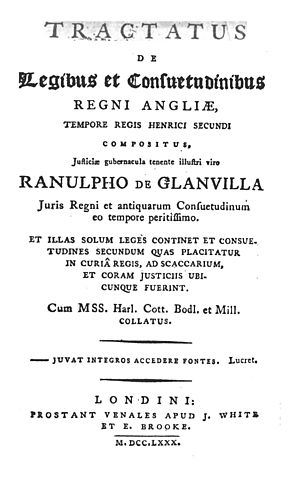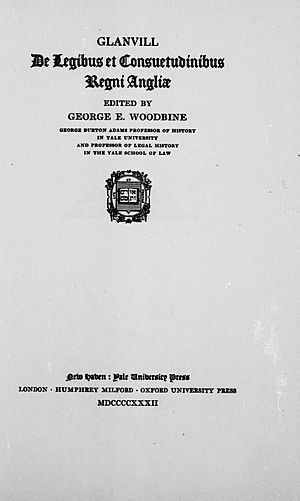Tractatus de legibus et consuetudinibus regni Anglie facts for kids
The Tractatus de legibus et consuetudinibus regni Angliae (Treatise on the Laws and Customs of the Kingdom of England), often called Glanvill treatise, is the earliest treatise on English law. Attributed to Ranulf de Glanvill (died 1190) and dated 1187–1189, it was revolutionary in its systematic codification that defined legal process and introduced writs, innovations that have survived to the present day. It is considered a book of authority in English common law.
Written for Henry II (r. 1154 – 1189) as the culmination of his long struggle to return the kingdom to peace and prosperity following years of anarchy, the Tractatus is fairly described as the means to implement Henry's objectives. It would be supplanted as a primary source of English law by the De legibus et consuetudinibus Angliae (On the Laws and Customs of England) of Henry de Bracton (c. 1210 – c. 1268), which itself owes much of its heritage to the Tractatus.
There has been debate over the actual author of all or parts of the Tractatus. The legal opinions of Glanvill's nephew, Hubert Walter are certainly cited. Whatever the case, Glanvill perhaps supervised and certainly approved the work, and the issue is sidestepped in the literature by using terminology such as "commonly attributed to Glanvill".
Contents
Document
In an age before widespread literacy and mechanical printing, it was common for all works, great and small, to borrow and copy from previous works without explicit attribution. The Preface of the Tractatus is commonly described as an admiring imitation of the Prœmium (Preface) to the Institutes of Justinian, with no negative implications of plagiarism. The Preface to the Institutes begins Imperatoriam Majestatem, but the Preface to the Tractatus begins Regiam Potestatem.
The Preface lays out the objectives, in effect saying that good laws and government are in the interests of justice, and these are the objectives of the King. The Tractatus consists of fourteen books, and is largely confined to objects of jurisdiction in the Curia Regis.
Fourteen books
| No. | Chapters | Contents |
|---|---|---|
|
|
|
Pleas belonging to the King's Court, or to the Sheriff; Essoins; the preparatory steps up to the time both parties to a suit appear in court |
|
|
|
Summons, Appearance, Pleadings, Duel or Grand Assize, the Champion, Judgement and Execution |
|
|
|
Vouching to Warranty; and of two Lords, under one of whom is the Demandant and under the other is the Tenant |
These first two books treat the Writ of Right, when originating in the Curia Regis, and all its stages. Taken with the third book, the three together are a description of the proceedings in a Writ of Right for the recovery of land, including all the stages relating to the Writ of Right.
| No. | Chapters | Contents |
|---|---|---|
|
|
|
Rights of the Ecclesiastical Advowsons |
|
|
|
Condition and Villeinage |
|
|
|
Dower |
|
|
|
Alienation, Descents, Succession, Wardship, Testaments |
|
|
|
final Concords and Records in general |
|
|
|
Homage, Relief, Fealty, Services, Purprestures, and Boundaries Disturbed |
|
|
|
Debts arising from different types of Contracts, Pledges and Gages (whether Movable or Immovable), Charters containing Debts |
|
|
|
Attorneys |
These first eleven books dispense with actions commenced originally in the Curia Regis.
| No. | Chapters | Contents |
|---|---|---|
|
|
|
Plea of Right and Writs of Right, when brought in the Lord's Court, and the manner of removing them to the County Court and Curia Regis; which leads to the mention some other Writs determinable before the Sheriff. |
|
|
|
Pleas by Assises and Recognitions, different kinds of Disseisins |
|
|
|
Criminal Pleas belonging to the Crown |
Versions
| Year | Description |
|---|---|
|
|
a revised version written or transcribed by Robert Carpenter of Haresdale, according to Glanvill Revised by Maitland |
|
|
Printed by R. Tottle in small 8vo; this was at the suggestion of judge and author Sir William Stanford, according to Coke. |
|
|
Printed by Thomas Wight; the text was corrected by the collation of "various manuscripts". |
|
|
Exact reprint of Wight's 1604 edition, but omitting the Preface. |
|
|
Printed in the first volume of Houard's Traités sur les Coutoumes Anglo-Normandes in quarto, Rouen. An imperfect text according to Gross. |
|
|
Published by John Rayner, 8vo. Collated with the Bodleian, Cottonian, Harleian, and Milles' manuscripts by J. E. Wilmot. |
|
|
English translation from Latin, published by John Beames in octavo, with notes. |
|
|
Printed as an appendix to George Phillip's Englische Reichs und Rechtsgeschichte, ii, 335. |
Descent
Immediate impact
The use of writs limited the jurisdiction of all other courts and transferred jurisdictions of lord and county courts to the King's Court. The mechanics of the eyre were used for a new institution, where several counties were combined into a circuit and a judge was appointed to ride the circuit, bringing the King's Court to every part of the kingdom. The general unwillingness to grant continuances (essoins) greatly reduced the time needed to complete judicial proceedings. The King's Court, through its writs, held ultimate jurisdiction in adversarial proceedings over real property. Establishing the "truth" of facts through the rational process of an Assize Court (later superseded by the jury) was given as an alternative to the options of trial by ordeal, or the use of champions as substitutes, or the use of character testimonials rather than evidence to determine the outcome of legal contests.
The emergence at this time of the doctrine of res judicata brought finality to the verdicts rendered, complementing the Tractatus though not a part of it, and serving to emphasize that the Tractatus was itself a part of Henry's reforms, but not the only part.
Ecclesiastical courts retained jurisdiction over matters of marriage, legitimacy, wills, ecclesiastical issues, and redress for breach of ordinary contracts, but the writs of the King's Court prevented them from intruding elsewhere.
The effect was unifying, and trial by jury in the King's Court was so popular that it deprived other courts of litigation. More important for the future of England, it was so satisfactory that it contributed to English culture by cultivating a universal respect for law and a willingness to abide by its decision.
In legal history
The writs and processes of the King's Court, together with the judicial organisation, are the germ of English common law. Similarly, the judicial oversight of property disputes through the use of writs are the germ for English land law. The option of the rational process of weighing evidence in a trial by jury would outlive all of its alternatives to become the only way to determine the "truth" of facts.
Glanvill is cited copiously by name in books on English law, whether chronological histories or subject-oriented legal books, and in the latter where there are a number of references relevant to the topic at hand, he is cited as the earliest authority. Spelling variations of the name include Glanvil, Glanvill (the most common), and Glanville.
The Regiam Majestatem
The Scottish Regiam Majestatem was written perhaps in the reign of Robert the Bruce (1306–1329) but not earlier than 1318, as it includes a Scottish statute written in that year. Some two-thirds of it was adapted without change from chapters of the Tractatus, and some of the rest is different from the Tractatus but very similar to it. The remainder of the Regiam Majestatem is unrelated to the Tractatus, and mostly covers the area of crimes.
See also
- English land law
- English contract law
- English law



